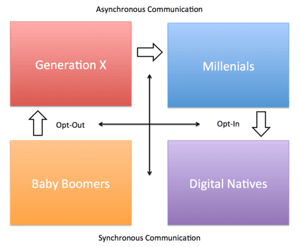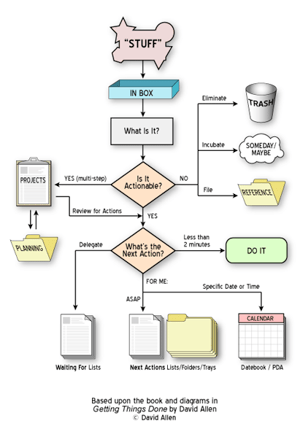When looking back at 2014, many trends will have a big impact on Software Marketing. For example, the fact that people are more interested in “Access to things” then “Owning things”, and the ongoing realization that the cost of usage is not about monetary cost, but how hard something is to use.
But the most interesting trend is something I first realized when walking into my 17-year-old Son’s room a few weeks ago. It helped me appreciate that the latest generation of kids entering college is about to teach us some lessons on getting things done, and about how they learn and consume information.
Here’s what happened.
Upon visiting his room I saw my Son in a Skype session with 8 friends at the same time. This is not so unique in itself, but the Skype session had been going on for over 9 hours! Some participants were chatting, but some feeds were empty as well. It was just running in the background. And when I walked in he introduced me to some of his friends. It was all very casual as if they were just hanging out in the same room.
They were actually working on homework together, gaming together, and filling out college applications together. All at the same time.
 After this had happened my son told me a story about a girl in their circle of friends that is suffering from bad nightmares. They got to know each other when she was in the US as an exchange student and now she lives on the other side of the world. So what does the group do to help her? They have an ongoing Skype video chat with the complete group of friends and this helps her sleep. Amazing.
After this had happened my son told me a story about a girl in their circle of friends that is suffering from bad nightmares. They got to know each other when she was in the US as an exchange student and now she lives on the other side of the world. So what does the group do to help her? They have an ongoing Skype video chat with the complete group of friends and this helps her sleep. Amazing.
What does this have to do with productivity in the workplace?
After seeing how my son and his friends use technology to work, play, and even sleep, it struck me that we have come full circle in how we get things done. In four generations we have moved across two dimensions as shown in the above picture.
Baby boomers – Sync / Opt-out
 My parents grew up feeling a phone call was an important event. It always needed to be answered right away. The protocol for answering the phone was a big deal. There were rules about when to call, and how to answer, but opting out from answering was not easy. In the workplace, team priorities were managed through paper memos, and interruptions were handled by phone. Communication was Synchronous (instant) and you could only “opt-out” by following some strong rules.
My parents grew up feeling a phone call was an important event. It always needed to be answered right away. The protocol for answering the phone was a big deal. There were rules about when to call, and how to answer, but opting out from answering was not easy. In the workplace, team priorities were managed through paper memos, and interruptions were handled by phone. Communication was Synchronous (instant) and you could only “opt-out” by following some strong rules.
Generation X – A-Sync / Opt-out
 I’m 43. My generation grew up in a workplace that was guided by new A-synchronous communication tools like fax, voicemail, e-mail and the electronic calendar. These tools drove our priorities. E-mail was to be answered within 24 hours. Voicemail Messages needed to be returned the same day. Although communication could now be dealt with “when you got to it” (A-synchronous), “opting-out” was still hard and only possible by following many new, unwritten rules.
I’m 43. My generation grew up in a workplace that was guided by new A-synchronous communication tools like fax, voicemail, e-mail and the electronic calendar. These tools drove our priorities. E-mail was to be answered within 24 hours. Voicemail Messages needed to be returned the same day. Although communication could now be dealt with “when you got to it” (A-synchronous), “opting-out” was still hard and only possible by following many new, unwritten rules.
There are long shelves of books, numerous blogs and expensive corporate training events developed to let my generation deal with “getting things done” in this new world of endless lists, scheduling tools and messaging platforms.
Millennials - A-Sync / Opt-in
“Texting is easier to get a hold of me. I rarely answer the phone #Millenials” – Michael, 28
The Millennial Generation (or Gen Y) that went to school with connectivity everywhere, and devices always at their fingertips, were not following the rules of Generation X. They treat A-Synchronous Email, Texting and Social Messaging as great tools that they opt-in to as they please. The amount of noise they had to deal with just did not fit an “opt-out” approach. This group has effectively improved a lot of tools (and “apps”) to manage email, collaboration and they fueled the social network revolution. Tools like slack are the new productivity tools that cater to this new "Opt-in/A-Sync" working style.
But the real revolution is happening now…
Digital Natives - Sync / Opt-in
.jpg?width=300&name=image-asset-compressor%20(1).jpg) After I witnessed the 9 members, 9 hour Skype session by my 17 year-old, I realized that he does not let email or an electronic calendar control his life. He does not feel the need to jump up and answer messages or any other form of interruption unless it fits his own priorities. For many years this had irritated me…but lately, I’ve starting to really admire it. I’m actually a bit jealous. Because he somehow still gets all his work done.
After I witnessed the 9 members, 9 hour Skype session by my 17 year-old, I realized that he does not let email or an electronic calendar control his life. He does not feel the need to jump up and answer messages or any other form of interruption unless it fits his own priorities. For many years this had irritated me…but lately, I’ve starting to really admire it. I’m actually a bit jealous. Because he somehow still gets all his work done.
The above observation was aligned with an experience I had this summer when we had two High School interns at our startup. One was 17, the other 16.
They were very productive. They got stuff done… But they didn’t spend much time on to-do lists, calendars, and productivity apps. They like to do things now. Instantly. So they prefer Synchronous communication over A-Sync tools like email and voicemail. Because the benefits of A-Sync tools as glorified scheduling- and archiving tools pales compared to the productivity gains of people being able to instantly work together across thousands of miles and time zones.
It’s like the old advice: "Don’t send an email if you can just ask someone a question and get an instant answer". The Digital Native generation is following this rule in everything they do, and is always connected with Skype or otherwise makes that easier than ever.
This is what’s happening with the Digital Native Generation. It’s about how we now do our best work in teams. We have gone from “what you know”, via “what you can find” to “who do you collaborate with”
I believe 2015 is going to be shaped much more by this trend. This is the generation that is going through college now. And the way the world gets stuff done is going to change very fast in the coming years.
Happy 2015!
